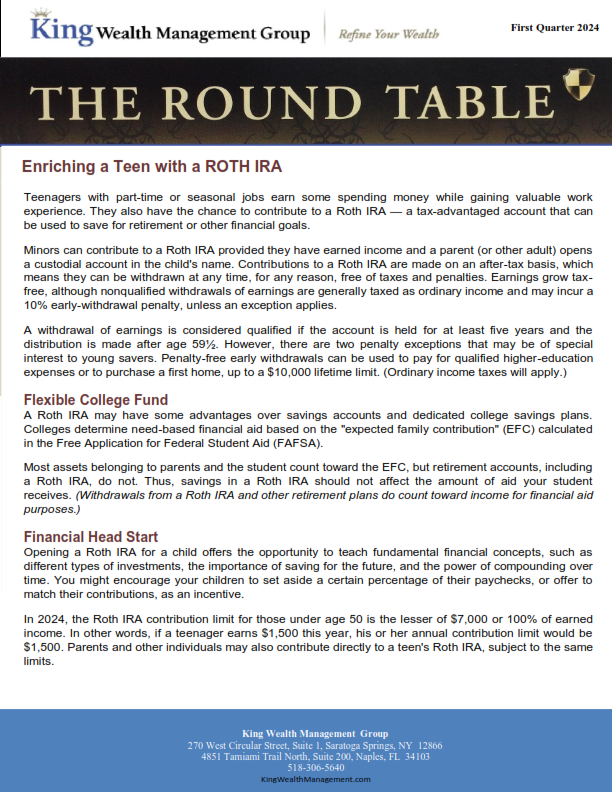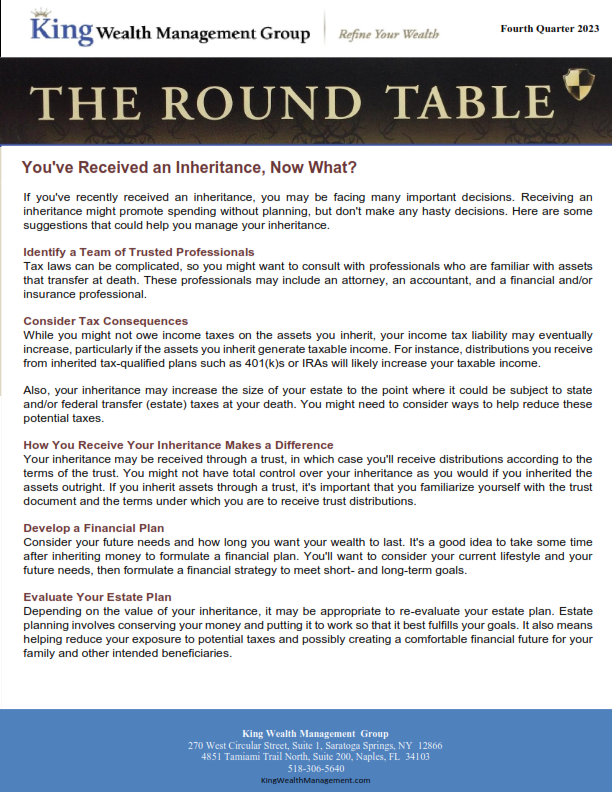Market News
Eye on the Market Week Ahead
As of market close of 4/26/2024
Stocks closed last week higher, driven up by tech and communication shares. Each of the benchmark indexes listed here climbed higher, led by the Nasdaq, which rose more than 4.0%. With nearly 50.0% of S&P 500 companies reporting first-quarter earnings, 77.0% reported positive earnings per share and 60.0% reported positive revenue according to the latest information from FactSet). Each of the market sectors closed last week ahead, with consumer staples and information technology leading the way. Ten-year Treasury yields rose 6.0 basis points. Crude oil prices were relatively flat. The dollar gained 0.5%, while gold prices fell 2.2%.
Wall Street saw an end to the bear run last Monday. Each of the benchmark indexes listed here posted solid gains, led by the Nasdaq, which climbed 1.1%. The Russell 2000 gained 1.0%, followed by the S&P 500 (0.9%), the Global Dow (0.8%), and the Dow (0.7%). Tensions in the Middle East eased, at least temporarily, as investors looked forward to a week of corporate earnings and key economic data. Each of the market sectors gained ground, with financials and information technology leading the way. The yield on 10-year Treasuries settled at 4.62%. The dollar was flat, while gold prices fell nearly 3.0%. Crude oil prices closed at $83.02 per barrel.
Stocks posted gains for the second straight day last Tuesday. The Russell 2000 (1.8%) and the Nasdaq (1.6%) led the benchmark indexes listed here, followed by the S&P 500 (1.2%), the Global Dow (1.0%), and the Dow (0.7%). Ten-year Treasury yields slipped to 4.57%. Crude oil prices rose $1.40 to $83.29 per barrel. The dollar and gold prices declined.
Stocks were mixed last Wednesday, unable to gain traction throughout the day. A strong set of earnings reports wasn’t enough to overcome investor concerns about rising interest rates. The Nasdaq, the S&P 500, and the Global Dow barely closed in the black, while the Russell 2000 fell 0.4% and the Dow dipped 0.1%. Ten-year Treasury yields gained 5.4 basis points to close at 4.57%. Crude oil prices lost $0.48 to settle at $82.88 per barrel. The dollar edged up 0.1%, while gold prices fell 0.4%.
Last Thursday saw stocks fall sharply after a lower-than-expected gross domestic product for the first quarter. The Dow fell 1.0%, followed by the Russell 2000 (-0.7%), the Nasdaq (-0.6%), the S&P 500 (-0.5%), and the Global Dow (-0.4%). Ten-year Treasury yields settled at 4.70%, an increase of 5.4 basis points. Crude oil prices climbed nearly $1.00 to $83.78 per barrel. The dollar dipped 0.3%, while gold prices gained 0.3%.
Strong earnings reports from some large tech companies helped propel stocks higher last Friday. The Nasdaq gained 2.0% on the day, while the S&P 500 and the Russell 2000 rose 1.0%. The Dow and the Global Dow advanced 0.4%. Ten-year Treasury yields slipped 3.7 basis points to 4.66%. Crude oil prices inched up $0.08. The dollar advanced 0.4%, while gold prices rose 0.3%.
Stock Market Indexes

Last Week's Economic News
- Gross domestic product increased 1.6% in the first quarter of 2024, according to the advance estimate, which is somewhat based on incomplete source data. Compared to the fourth quarter, the decline in GDP in the first quarter primarily reflected decelerations in consumer spending, exports, and state and local government spending, and a downturn in federal government spending. These movements were partly offset by an acceleration in residential fixed investment. Imports, which are a negative in the calculation of GDP, accelerated. The personal consumption expenditures price index increased 3.4% in the first quarter, compared with a fourth-quarter increase of 1.8%. Excluding food and energy prices, the PCE price index increased 3.7% in the first quarter, compared with an increase of 2.0% in the previous quarter.
- Consumer prices rose 0.3% in March and 2.7% over the last 12 months. Prices less food and energy also increased 0.3% for the month and 2.8% for the year. The annual rates, as aforementioned, are above expectations. Consumer spending rose 0.8% last month, while personal income increased 0.5%.
- Sales of new single-family homes in March were 8.8% above the February estimate and 8.3% over a year ago. The median sales price of new homes sold in March was $430,700. The average sales price was $524,800. Inventory of new single-family homes for sale in March sat at an 8.3-month supply at the current sales pace.
- Orders for durable goods rose 2.6% in March after rising 0.7% in February. Transportation equipment, led the increase, rising 7.7%. Excluding transportation, new orders increased 0.2%. Excluding defense, new orders increased 2.3%. New orders for nondefense capital goods in March advanced 5.4%. New orders for defense capital goods jumped 10.6% last month.
- The advance report on the international trade in goods deficit was $91.8 billion in March, up $1.5 billion, or 1.7%, from $90.3 billion in February. Exports of goods for March were $169.2 billion, $6.1 billion, or 3.5%, less than February exports. Imports of goods for March were $261.0 billion, $4.6 billion, or 1.7%, less than February imports.
- The national average retail price for regular gasoline was $3.668 per gallon on April 22, $0.040 per gallon above the prior week’s price and $0.012 per gallon more than a year ago. Also, as of April 22, the East Coast price increased $0.089 to $3.540 per gallon; the Midwest price dipped $0.002 to $3.463 per gallon; the Gulf Coast price increased $0.055 to $3.232 per gallon; the Rocky Mountain price rose $0.028 to $3.456 per gallon; and the West Coast price decreased $0.021 to $4.832 per gallon.
- For the week ended April 20, there were 207,000 new claims for unemployment insurance, a decrease of 5,000 from the previous week’s level. According to the Department of Labor, the advance rate for insured unemployment claims for the week ended April 13 was 1.2%, unchanged from the previous week’s rate. The advance number of those receiving unemployment insurance benefits during the week ended April 13 was 1,781,000, a decrease of 15,000 from the previous week’s level, which was revised down by 16,000. States and territories with the highest insured unemployment rates for the week ended April 6 were New Jersey (2.7%), California (2.3%), Rhode Island (2.1%), Massachusetts (2.0%), Minnesota (2.0%), Illinois (1.9%), New York (1.9%), Pennsylvania (1.7%), Washington (1.7%), Alaska (1.6%), Nevada (1.6%), and Puerto Rico (1.6%). The largest increases in initial claims for unemployment insurance for the week ended April 13 were in California (+2,405), Connecticut (+1,613), Georgia (+1,419), Oregon (+1,397), and New York (+506), while the largest decreases were in New Jersey (-4,370), Wisconsin (-1,843), Pennsylvania (-1,604), Illinois (-1,573), and Minnesota (-1,274).
Eye On the Week Ahead
The Federal Open Market Committee meets this week. It is unlikely that interest rates will be lowered following this meeting. However, it will be interesting to see if the Committee changes its projections for interest rate reductions going forward. Following their last meeting, the Fed projected three interest rate reductions during 2024. Also out this week is the jobs data for April. Over 300,000 new jobs were added in March as the labor sector continued to show strength.
Data Sources
Economic: Based on data from U.S. Bureau of Labor Statistics (unemployment, inflation); U.S. Department of Commerce (GDP, corporate profits, retail sales, housing); S&P/Case-Shiller 20-City Composite Index (home prices); Institute for Supply Management (manufacturing/services). Performance: Based on data reported in WSJ Market Data Center (indexes); U.S. Treasury (Treasury yields); U.S. Energy Information Administration/Bloomberg.com Market Data (oil spot price, WTI, Cushing, OK); www.goldprice.org (spot gold/silver); Oanda/FX Street (currency exchange rates).
News items are based on reports from multiple commonly available international news sources (i.e., wire services) and are independently verified when necessary with secondary sources such as government agencies, corporate press releases, or trade organizations. All information is based on sources deemed reliable, but no warranty or guarantee is made as to its accuracy or completeness. Neither the information nor any opinion expressed herein constitutes a solicitation for the purchase or sale of any securities, and should not be relied on as financial advice. Forecasts are based on current conditions, subject to change, and may not come to pass. U.S. Treasury securities are guaranteed by the federal government as to the timely payment of principal and interest. The principal value of Treasury securities and other bonds fluctuates with market conditions. Bonds are subject to inflation, interest-rate, and credit risks. As interest rates rise, bond prices typically fall. A bond sold or redeemed prior to maturity may be subject to loss. Past performance is no guarantee of future results. All investing involves risk, including the potential loss of principal, and there can be no guarantee that any investing strategy will be successful.
The Dow Jones Industrial Average (DJIA) is a price-weighted index composed of 30 widely traded blue-chip U.S. common stocks. The S&P 500 is a market-cap weighted index composed of the common stocks of 500 largest, publicly traded companies in leading industries of the U.S. economy. The NASDAQ Composite Index is a market-value weighted index of all common stocks listed on the NASDAQ stock exchange. The Russell 2000 is a market-cap weighted index composed of 2,000 U.S. small-cap common stocks. The Global Dow is an equally weighted index of 150 widely traded blue-chip common stocks worldwide. The U.S. Dollar Index is a geometrically weighted index of the value of the U.S. dollar relative to six foreign currencies. Market indexes listed are unmanaged and are not available for direct investment.
2024 Broadridge Investor Communication Solutions, Inc. All rights reserved.



